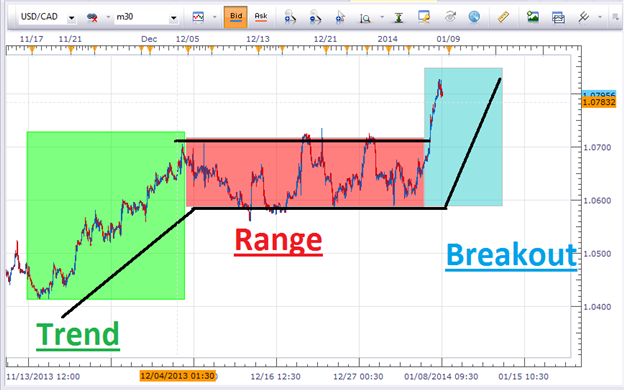- Always identify market conditions prior to trading
- Your strategy and entries should reflect the market
- Plan your risk and write your trades down to stay accountable
Traders should have a checklist to consult prior to making any major trading decisions. These steps are critical for Forex scalpers as they often have to make these choices on a moment’s notice. To help with the process it can be helpful to keep a checklist and determine your options prior to approaching the market. Today we will review the scalper’s checklist. Let’s get started!
Identify Market Conditions
The first task assigned to day traders and scalpers is to identify market conditions. Is the market trending or ranging? Is the volatility of an asset low or high? These are both important questions that should be answered prior to entering into a new trade idea. Not only will this help Forex traders which currency pair to trade, but also help determine their strategy. Every scalper and day trader should check this off their list, prior to considering any market entries!

Choose a Strategy
Once market conditions are found, traders need to identify a strategy that is congruent with the market. If you are trading a trend, you will need to not only find market direction but also decide if you are going to trade a retracement, momentum or breakout strategy. In lack of a trend, traders again need to decide how to approach pricing patterns, support & resistance values, as well as potential breakouts. With so many strategies to choose from, it is worth taking your time and doing your due diligence prior to checking this off your scalping list.
Plan Your Entry
Next traders need to select how they are going to enter into the market. Typically traders need to first determine if they will trade with market orders or entry orders. Market orders allow you to trade immediately if conditions are met and you are immediately in front of your trading terminal. Entry orders can be used and will execute at a designated price even if you aren’t watching the market.
Once this is decided, traders need to evaluate which indicators if any will be used for trading. In the event an indicator is added to the graph, prior to execution, plan on its use and know its strengths as well as limitations. When you are 100% certain on your entry triggers then you can proceed to the next portion of the checklist.
Manage Risk
This point of our check list goes beyond the simple placement of stop and limit orders. Scalpers must carefully consider how much they should risk on each trade. At this point specific questions should arise. How many pips are you risking per trade? What is your average profit target per trade? How does a stop order being executed equate to a loss on my account?
While no trader wants to take a loss it is paramount to determine these values prior to scalping. Once these values are set, you can mark this point off your checklist. Now all you have left is to hold yourself accountable to your trading decisions.

Log the Results
Traders, especially short term scalpers, have a tendency to always be looking for the next trade. While looking for trading opportunities isn’t a bad thing, we should also remember to go back and review past events. Keeping a trading log can help us establish market patterns and reflect if your strategy is working in current conditions.
To help with this process, traders should note, why, when and how they entered into a trade. If your strategy is working, stick with it and keep your original strategy rules. If you’re trading is not working out as planned, with a log you can identify what must be changed and make appropriate adjustments.
While this checklist may seem daunting at first, these are all important steps to consider before scalping. To help you along the way, read through The Definitive Guide to Scalping. This is a great resource to review prior to tackling some of trading’s tougher challenges!
The Definitive Guide to Scalping, Part 1: Market Conditions
The Definitive Guide to Scalping, Part2: Currency Pairs
The Definitive Guide to Scalping, Part 3: Time Frames
The Definitive Guide to Scalping, Part4: Support & Resistance
The Definitive Guide to Scalping, Part5: Scalping Ranges
The Definitive Guide to Scalping, Part6: Scalping Retracements
The Definitive Guide to Scalping, Part7: Scalping Breakouts
The Definitive Guide to Scalping, Part8: Risk Management
---Written by Walker England, Trading Instructor
To contact Walker, email instructor@dailyfx.com. Follow me on Twitter @WEnglandFX.
To be added to Walker’s e-mail distribution list, CLICK HERE and enter in your email information.
New to the FX market?Save hours in figuring out what FOREX trading is all about.
Take this free 20 minute“New to FX”course presented by DailyFX Education. In the course, you will learn about the basics of a FOREX transaction, what leverage is, and how to determine an appropriate amount of leverage for your trading.
Register HERE to start your FOREX learning now!




